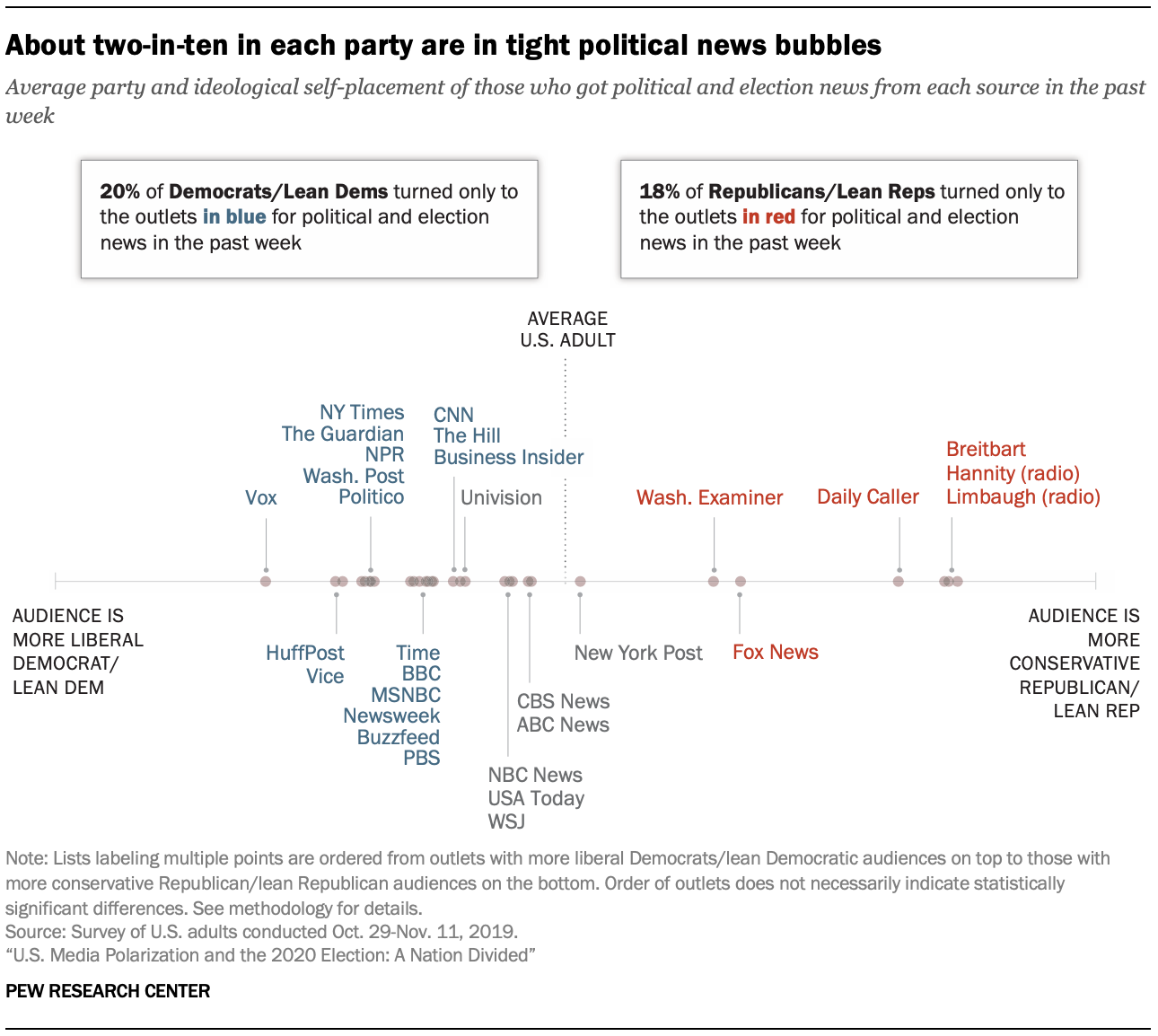
To a large degree, the pattern of partisan polarization that emerges in attitudes about the credibility of news sources is also evident in the sources that Republicans and Democrats rely on for news about politics and the election.
Overall, Republicans (and independents who lean Republican) get political and election news from a smaller group of sources than Democrats, with an overwhelming reliance on one source – Fox News. Democrats (including independents who lean Democratic), on the other hand, use a wider range of sources.
Six-in-ten Republicans say they got news from the Fox News cable network in the past week. After Fox News, there is a huge gap before the next most turned-to sources – ABC News, NBC News and CBS News, all at similar levels (30%, 28%, and 26% respectively).
Despite Republicans’ deep distrust of CNN, it is among the more commonly used sources among Republicans, with 24% who got political news there in the past week. Next come the radio shows of Sean Hannity (19%) and Rush Limbaugh (17%). No other source tops 15% among Republicans.
On the Democratic side, CNN is turned to by the greatest portion, with 53% saying they got political news there in the past week. As is the case with Republicans, the three major commercial broadcast networks are the next most turned to sources of political news for Democrats, albeit in bigger doses — NBC (40%), ABC (37%) and CBS (33%).
One-third of Democrats also got news from cable channel MSNBC (33%) in the past week. A similar share got political news from The New York Times (31%) and NPR (30%). About a quarter got news from The Washington Post (26%) and Fox News (23%).
Amid these divides, there are some in each party who turn to the most relied-on sources of the other party: Roughly a quarter of Republicans (24%) got political news from CNN in the past week, which virtually matches the percentage of Democrats (23%) who say the same of Fox News. In other words, even amid the tendency of partisans to seek political news from different sources, there is still some overlap in what partisans see.
Partisan divides lead to one-sided audiences for many news outlets
The preference for news sources based on party identification and ideology affects the partisan makeup of the audience of each outlet, as shown below. Each source is placed on the line graph according to those who said they got political and election news there in the past week – taking into consideration both party identification (Republican or Democrat, including leaners) and ideology (conservative, moderate or liberal). (For more details see the methodology.)

For example, the average audience member of The New York Post sits very close to the party and ideology of the average U.S. adult. The average audience member of Breitbart, the Sean Hannity radio show and Rush Limbaugh’s radio program sit further to the right, as they tend to be more conservative and Republican. Fox News, even as it is turned to by large portions of conservatives Republicans, also has substantial numbers of more moderate Republicans and Democrats who get some news from it. Thus, Fox News sits closer to the middle than Breitbart and some others. It is worth noting that most of these outlets have an audience that falls at least slightly to the left of the average U.S. adult.

Americans’ use of a news outlet does not always mean they trust it

Even as Republicans and Democrats sort themselves into different news universes, there are a few sources that are used by large numbers on both sides.
A deeper analysis reveals, however, that getting political news from a source does not always mean one trusts it. Indeed, some people report getting news from sources they also say they distrust. This is particularly true among Republicans. For example, among the 24% of Republicans who said they got political and election news from CNN in the last week, about four-in-ten (39%) say they distrust CNN. Conversely, among the 53% of Democrats who use CNN, just 4% distrust it.
Similarly, for each of the three major commercial broadcast networks, about two-in-ten Republicans who got political news from these outlets in the past week also say they distrust that source (24% of Republicans who got news from NBC distrust it, 22% for CBS and 21% for ABC).
And while relatively small numbers of Republicans got news from MSNBC (14%), The New York Times (9%) and The Washington Post (8%) in the past week, of those who did, 45% distrust The Washington Post, 38% distrust The New York Times and 37% distrust MSNBC.
For Democrats, the data tells a different story. With one exception, few Democrats say they got news in the past week from sources they distrust. The exception is Fox News. Nearly one-quarter of Democrats (23%) got news there in the past week. And of those who did, 27% say they do not trust the cable channel as a source of information about the election and politics.